Centauri Dreams
Imagining and Planning Interstellar Exploration
New Findings on Rogue Planets
Gravitational microlensing to the rescue. We now have evidence for the existence of the rogue planets — interstellar wanderers moving through space unattached to any star system — that we talked about just the other day. It’s been assumed that such planets existed, because early solar systems are turbulent and unstable, with planetary migrations like those that lead to ‘hot Jupiters’ in the inner system. Moving gas giants into orbits closer to their star would cause serious gravitational consequences for other worlds in the system, ejecting some entirely.
But while we’ve been thinking in terms of detecting such worlds through auroral emissions like those produced by Jupiter, researchers at two microlensing projects have made a series of detections by using gravity’s effects upon spacetime. Specifically, a stellar system passing in front of a far more distant background star will warp the light of the background object. The resulting magnification and brightening flags the presence of the intermediate object, and surveys like Microlensing Observations in Astrophysics (MOA), based in New Zealand, have developed the necessary expertise to distinguish between intermediate stars and planets.
Both MOA, which scans the galactic center for these microlensing events, and the Optical Gravitational Lensing Experiment (OGLE), using a 1.3 meter telescope in Chile, have studied and built a case for the existence of up to 10 rogue planets of roughly Jupiter mass. Microlensing because of its nature picks up objects a long way from our stellar neighborhood — these average between 10,000 and 20,000 light years from Earth. Extrapolating from the lensing probabilities, the efficiency of their equipment and the rate of lensing, the researchers now conclude that there could be as many as 400 billion rogue planets in the Milky Way.
How Do Rogue Planets Form?
That’s a big number, but at this point we’re still shooting in the dark. After all, lower-mass planets should be ejected from young solar systems more frequently than the gas giants this work has detected, which is why planet hunter Debra Fischer (Yale University) told Nature News in a related story that lighter planets “…might be littering the galaxy.” What a scenario, particularly given the possibility that a hydrogen atmosphere could trap enough heat to allow the presence of liquid oceans. Unfortunately, the current survey was not sensitive enough to detect planets smaller than Saturn.
This work is getting huge play in the press, but I think it raises as many questions as it answers, for the scenario shifts depending on how these wandering worlds were formed. The current work draws on the idea that they were the result of ejection from solar systems. In fact, David Bennett (University of Notre Dame), a co-author of the study in Nature, assumes ejection as the primary mechanism:
“If free-floating planets formed like stars, then we would have expected to see only one or two of them in our survey instead of 10,” Bennett said. “Our results suggest that planetary systems often become unstable, with planets being kicked out from their places of birth.”
And if ejection is the driver here, then we should assume a huge population of low-mass planets moving through space without any star, just like these gas giants. But if there is another formation mechanism at work (Greg Laughlin speculates about this in the Nature News article I linked to above), then the low-mass wanderers are much less prevalent. Right now we just don’t know, because we would need a formation mechanism that would account for objects not much larger than Jupiter, “…something more similar to that of a tiny star than a giant planet,” Laughlin adds. Whether or not ejection is the mechanism thus becomes crucial for any hypothesis about rogue ‘Earths.’
Outer Orbits and Unseen Hosts
Also in play is the question of whether the ten detections could be of gas giants in planetary orbits around stars that were simply not detected. The study sees no host stars within 10 AU, a figure that remains relatively close to any potential host. We don’t have a firm answer, and I see that Alan Boss (Carnegie Institution) told the New York Times‘ Dennis Overbye that this scenario is the more likely one. If that’s the case, then we should look with even greater interest at data from the WISE (Wide-Field Infrared Survey Explorer) mission, which should have been able to spot any gas giant lurking in the distant regions of the Oort Cloud. Ten detections like this would imply such outer orbits may be common around stars.
Where we go from here seems obvious: We need to confirm there are no host stars. If we do, then the presence of twice as many rogue gas giants as there are stars in the galaxy is enough to take the breath away, whether or not they’re in the company of rogue ‘Earths.’ The planned Wide-Field Infrared Survey Telescope (WFIRST) might be able to make a detection of such Earth-mass rogue planets and give us some constraints on their numbers. We’ll also learn, as we continue the study of galactic wanderers, to tighten up our theories of planet formation and migration to account for the suddenly increased population of sub-stellar objects among the stars.
The paper is Sumi et al., “Unbound or distant planetary mass population detected by gravitational microlensing,” Nature 473 (19 May 2011), 349-352 (abstract).

New Views of a Cometary Core
We looked recently at Titan Mare Explorer (TiME), a mission to land a probe on Titan’s Ligeia Mare, a methane-ethane sea that would be observed for an extended period by this floating observatory. But I don’t want to pass too quickly over Comet Hopper, one of the other missions being considered by NASA’s Discovery Program. This one is a proposal out of the University of Maryland that would land on comet 46P/Wirtanen not once but multiple times, observing the changes on the comet and in its innermost coma as it interacts with the Sun.
The innermost coma is the comet’s atmosphere immediately above the nucleus, where cometary jets and outgassing originate. Jessica Sunshine, principal investigator for Comet Hopper, says the idea is to watch how surface and coma change through a solar approach:
“We’ve had some amazing cometary flybys but they have given us only snapshots of one point in time of what a comet is like. Comets are exciting because they are dynamic, changing throughout their orbits. With this new mission, we will start out with a comet that is in the cold, outer reaches of its orbit and watch its activity come alive as it moves closer and closer to the Sun.”
Comet Hopper is being portrayed as a reconnaissance mission for an even more ambitious effort, the Comet Nucleus Sample Return mission, proposed to the European Space Agency’s Cosmic Vision program as a way to retrieve three sample cores from different locations on a cometary nucleus. We’ll see how Comet Hopper fares as it works its way through the Discovery Program process. Titan Mare Explorer and the Mars-oriented Geophysical Monitoring Station (GEMS) have also received funding from the program to develop their respective mission concepts, with one of the three to be chosen after a 2012 review.
Homing in on Hartley 2
Meanwhile, comets remain in the news in the form of new findings about Comet 103P/Hartley 2, recently studied by the EPOXI spacecraft in a 2010 flyby. One research effort draws on imagery from the 2.1-meter instrument at Kitt Peak in Arizona, using a blue filter to isolate the light emitted by cyanogen (CN) molecules in the coma of the comet. The variations over short time scales were striking, according to Nalin H. Samarasinha (Planetary Science Institute):
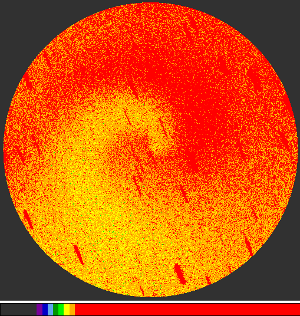
“The rotational state of a comet’s nucleus is a basic physical parameter needed to accurately interpret other observations of the nucleus and coma. Analysis of these cyanogen features indicates that the nucleus is spinning down and suggests that it is in a state of a dynamically excited rotation. Our observations have clearly shown that the effective rotation period has increased during the observation window.”
Image: An image of comet Hartley 2 taken on Sept. 3, 2010 at the 2.1 meter telescope at the Kitt Peak National Observatory near Tucson, Ariz. In this image, red denotes regions where CN gas is more abundant. The image is enhanced by removing the underlying background in order to highlight the jet feature present. North is up and east is to the left. The image is nearly 50,000 miles across and the comet nucleus which is not resolved is at the center. The red streaks are star trails. Credit: PSI.
The findings indicate just how active Hartley 2 is. Its nucleus is a scant two-kilometers long, but its rotational changes are clearly being caused by jets of gases emitted from the icy body. This is exactly the kind of information we need as we continue to study both comets and asteroids to learn how to deal with any future objects that may be on a collision course with the Earth. Samarasinha points out that the material properties of comets are crucial for such purposes:
“…fortunately for the first time, we are on the threshold of our technical knowhow to mitigate such a hazardous impact,” Samarasinha said. “In order to do that we need to know the material properties of comets. The most appropriate mitigation strategy for a strong rigid body is different from that for a weakly bound agglomerate.”
Exploring a Cometary Core
At NASA GSFC, Michael Mumma and team collected data from telescopes in Hawaii and Chile as part of the worldwide effort to add to our knowledge of Hartley 2, folding in their findings with images taken by EPOXI. The combined work indicates that the comet’s core is not uniform, but appears to contain two and possibly three different kinds of ice. This is where a mission like Comet Hopper could be valuable, with its ability to make in situ investigations at multiple sites on the surface of the nucleus. The ices in Hartley 2 are primarily made of water, along with traces of other kinds of molecules. These remain frozen until warmed by the Sun, when they become swept up into the coma.
Knowing of the comet’s rapid rotation, the researchers studied how these molecules were detected during each rotation, finding not only swift changes in the amount of water but equivalent changes in the amounts of the other gases. “This is the first time anyone has seen an entire suite of these gases change in the same way at the same time,” says Mumma. It’s a significant result because cometary gases are usually studied one at a time. Examining the simultaneous behavior of a whole range of gases helps scientists get a better idea of the comet’s composition.
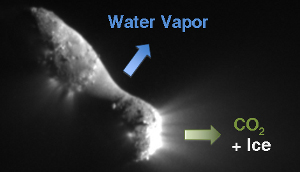
But EPOXI had shown a large variation in the release of carbon dioxide relative to water. What seems to be happening is that chunks of water ice are glued in the cometary core by frozen carbon dioxide. The latter evaporates before the water ice, dragging ice grains out of the comet that later evaporate to produce water vapor in the coma. The process hasn’t been seen in other comets. Moreover, EPOXI found variations in the location of carbon dioxide, showing that the composition of the core changes from one region to another.
Image: Jets spew out ice and carbon dioxide from one end of comet Hartley-2 in this EPOXI image, while water vapor gets released from the middle region. The differences suggest that the comet’s core is made of at least two different ices. Ground-based measurements suggest the presence of a third ice. Credit: NASA/JPL-Caltech/UMD.
Mumma’s team confirms the finding, examining four types of gas to see how they were produced. Water and methanol came off the comet in all directions. Says Mumma:
“Because they are found together, we infer that they come from the same chunks of ice. So, we have water ice with methanol in it, and we have carbon dioxide ice. Both are in the comet’s core. We may also have a third type of ice, made from ethane [the ethane was released strongly in one direction]. This is actually rather profound. It suggests that some molecules, such as methanol, may be mixed with water, while others, such as ethane, are not. This isn’t the way we’ve thought of comets, before now.”
Mumma says Hartley 2 could be “…the first of a new breed.” But learning more about how comets are formed and how they behave as they make their approach to the Sun is clearly high on the priority list for near-term missions, whether Comet Hopper flies or not. Comets offer not only a window into the early history of the Solar System but a possible source of materials as we look toward the human exploration of the planets. Knowing their properties will also help us map strategies in the unlikely but not inconceivable event that a cometary impact with the Earth looms in our future.
The Samarasinha paper is “Rotation of Comet 103P/Hartley 2 from Structures in the Coma,” Astrophysical Journal Letters 734 No. 1 (16 May 2011), L3 (abstract). See also other papers in the same issue, including Weaver et al., “The Carbon Monoxide Abundance in Comet 103P/Hartley 2 During the EPOXI Flyby” (abstract), Dello Russo et al., “The Volatile Composition and Activity of Comet 103P/Hartley 2 During the EPOXI Closest Approach” (abstract) and Meech et al., “EPOXI: Comet 103P/Hartley 2 Observations from a Worldwide Campaign” (abstract)

Finding an Interstellar Wanderer
Imagine a planet far more massive than Jupiter and spinning faster than Jupiter’s 10 hour rotation. Throw in a large nearby moon and the associated auroral effects that would occur as the moon moved through fields of plasma trapped in the planet’s magnetic field. The scenario isn’t all that different from what we see happening between Jupiter and Io. But here’s the kicker: Put planet and moon far away from any star, a rogue planet scenario of the kind recently discussed by Dorian Abbot and Eric Switzer, who called such rogue planets ‘Steppenwolfs.’ I jumped on that idea in a Centauri Dreams post last February because interstellar planets have always fascinated me.
Abbot and Switzer were interested in whether a rogue planet could support life, finding in their paper that a planet just 3.5 times as massive as the Earth, and with the same basic composition and age, could sustain a liquid ocean under layers of insulating water ice and frozen atmosphere. But our rogue gas giant offers something the smaller world cannot. The auroral effects created by planet and moon could be detected out to a distance of 185 light years, provided the planet were big enough and we had the appropriate equipment, which in this case means the Square Kilometer Array radio telescope. So says Heikki Vanhamaki of the Finnish Meteorological Institute in Helsinki.
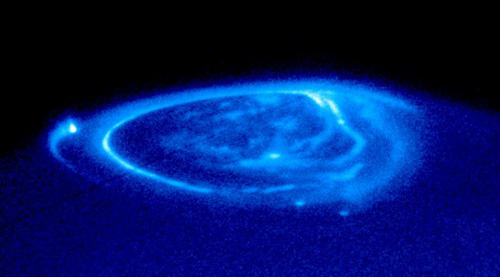
Image: Aurora on Jupiter, as detected by the Hubble Space Telescope. Can we use the emissions of such events to detect a planet wandering between the stars? Credit: NASA and the Hubble Heritage Team (STScI/AURA) Acknowledgment: NASA/ESA, John Clarke (University of Michigan).
You may recall that we also looked recently at Jonathan Nichols’ work at the University of Leicester on how an exoplanet aurora could be used as a detection tool. Vanhamaki’s calculations show that such an aurora could be produced by a rogue planet in two different ways. Movement through interstellar plasma could generate an aurora, but the scenario above, in which a moon moves through magnetically trapped plasma, produces a signature 100 times stronger. The scientist calls detection of a rogue Jupiter extremely unlikely — “perhaps nearly impossible” — in the forseeable future, but he adds that there may be 2800 interstellar planets within 185 light years, the distance within which he calculates a Square Kilometer Array might be effective.
One or more of them will have to be large enough, at least eight Jupiter masses, and orbited by a moon inducing auroral activity, for any of this to work. It’s the slimmest of chances, but earlier studies of known ‘hot Jupiters’ have predicted that some of them should produce cyclotron radiation of between 1014 and 1016 W, orders of magnitude higher than the values Vanhamaki discusses for typical interstellar planets, although these emissions have not yet been detected. Nonetheless, exoplanet aurorae seem like a promising area of research, and the suspicion that biological processes could go to work on a rogue planet makes the hunt more enticing. Says Vanhamaki:
“It has been speculated that Earth-like rogue planets could have very thick atmosphere that keeps them relatively warm, or moons of giant rogue planets could experience tidal heating and have oceans beneath their icy surface.”
It’s a scenario that once again turns our notion of the habitable zone on its head. We’ve gone from describing a habitable zone as a region around a star where liquid water could be maintained at the surface to seeing the possibilities of life under frozen oceans, a zone that could extend all the way to the Kuiper Belt. A rogue planet would be the ultimate habitable zone extension. If it has no reflected starlight by which to spot it, will the auroral method come into its own with a breakthrough detection?
Recall, too, that Christopher McKay (NASA Ames) has looked at a variety of scenarios involving Titan-like worlds, placing them around several red dwarf stars to see where they could host oceans of liquid methane. One idea his team looked at was a rogue Titan in interstellar space. The conclusion: A Titan with 20 times the geothermal heat of Earth could keep its current surface temperature in the absence of any star. Alternatively, an atmosphere 20 times thicker than Titan’s could retain enough heat to make a surface ocean viable. These are tall orders, but a larger Titan with a thicker atmosphere might sustain a liquid methane sea.
The Vanhamaki paper is “Emission of cyclotron radiation by interstellar planets,” Planetary and Space Science, published online 17 April 2011 (abstract). Christopher McKay’s paper is “Titan under a red dwarf star and as a rogue planet: requirements for liquid methane,” Planetary and Space Science, published online 2 April 2011 (abstract). Astrobiology Magazine covers the story here.

SETI Search Focuses on Kepler Planets
The canonical notion of the ‘water hole’ is that the kind of life we are looking for in our SETI searches will only thrive where there is liquid water. A quiet stretch of the radio spectrum, the water hole has two natural boundaries: The 18 cm emissions from the hydroxyl ion (OH) and the 21 cm emissions from neutral hydrogen. But the choice of frequencies for SETI is obviously not based on mere symbolism. The water hole is a window in the radio spectrum where radio emissions are not significantly absorbed by interstellar dust and other matter between the stars. It’s a natural place to look, and SETI@Home users worldwide have used Arecibo data from the waterhole to participate in the hunt, in what has turned out to be a massive distributed computing project.
But the latest SETI project to hit the news following the hibernation of the Allen Telescope Array last month goes where Arecibo cannot. This is a new effort at a storied place, the Green Bank facility in West Virginia. This is where Frank Drake launched Project Ozma back in 1960, although the UC-Berkeley astronomers behind the new effort will be using a new dish which happens to be the largest steerable radio telescope in the world. They’re going to work on 86 stars chosen from the 1235 candidate planetary systems thus far identified by the Kepler space observatory.
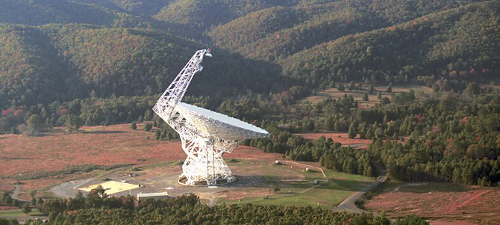
Image: The Robert C. Byrd Green Bank Telescope in West Virginia, the largest steerable radio telescope in the world, is observing 86 planetary systems that may contain Earth-like planets in hopes of detecting signals from intelligent civilizations. (Courtesy NRAO).
So why Green Bank and not Arecibo for this new hunt? In a word, location. The Arecibo dish is fixed and can’t observe the area of sky — covering the northern constellations of Cygnus, Lyra and Draco, well outside the ecliptic plane — that this search requires. Moreover, the scientists doing SETI via Arecibo are working around other astronomical observation efforts and they’re limited to the 21 cm area of the spectrum. The new effort hopes to extend that range, says Dan Werthimer, chief scientist for SETI@Home:
“Searching for ET around the 21 centimeter line works if civilizations are broadcasting intentionally, but what if planets are leaking signals like ‘I Love Lucy’? With a new data recorder on the Green Bank telescope, we can scan a 800 megaHertz range of frequencies simultaneously, which is 300 times the range we can get at Arecibo.”
The result: A single day on the Green Bank instrument produces as much SETI data as a year’s worth of observations at Arecibo, some 60 terabytes in all. The water hole is still in play but not a limiting factor in these efforts. Werthimer’s team will take an early run through the data, but SETI@Home users will put their processing power to work crunching the numbers in greater detail, an analysis that could take as much as a year to perform. It’s a nice touch that the software will indicate to users whether they’re working with Arecibo or Green Bank data as the Kepler hunt proceeds.
We need to get used to the relatively new acronym KOI — Kepler Object of Interest. The 54 candidate systems identified by the Kepler team as possibly being in the habitable temperature range — defined here as between 0 and 100 degrees Celsius, where liquid water can exist — are among the 86 stars chosen for the search, which includes other planets with orbital periods greater than 50 days and systems with four or more possible planets. Green Bank will scan these 86 stars individually but will also scan the entire Kepler field at the end of the search. And by the time SETI@Home has gone through this round of data, we should have a whole new batch of KOIs to contend with.

JBIS: Celebrating the ‘Red Cover’ Issues
Working on a book on interstellar flight in 2002, I came across a paper in the Journal of the British Interplanetary Society with a bold title: “A Programme for Interstellar Exploration.” I already knew that its author, Robert Forward, was a major figure in the world of deep space studies, an aerospace engineer and inventor with a deep knowledge of physics as well as a popular science fiction author, in whose stories many of his futuristic ideas were played out. What I didn’t know until I read the paper was that this man had proposed a step-by-step plan for reaching the stars way back in 1975 at a meeting at the U.S. House of Representatives.
These were bold years for interstellar thinking, as witness Forward’s appearance before the Subcommittee on Space Science and Applications that year. Forward developed a fifty-year plan for interstellar exploration that, in his words, ‘envisions the launch of automated interstellar probes to nearby stellar systems around the turn of the century, with manned exploration commencing 25 years later.’ He went on to discuss five possibilities for interstellar propulsion systems based on a series of projections of technology programs in nuclear fusion, particle physics, high-power lasers and thermonuclear explosives. Imagine Forward telling these political leaders that a manned starship might embark for Alpha Centauri by the year 2025.
A Home for Visionaries
It all seems a bit surreal, given what has happened to our space plans after Apollo, but Forward’s paper on these matters in JBIS is still lively reading, and so is another interstellar program put forward by Michael Michaud, then an official with the U.S. State Department. Michaud’s plan discussed the possibilities of interplanetary exploration and moved into the interstellar realm by envisioning a search for extrasolar planets (at the time, of course, we knew of none). His closely reasoned program for colonizing the Solar System would in his schedule be followed by the first star probes using fusion technologies beginning around 2010 .
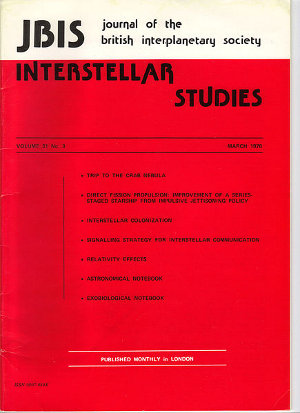
Here again I turned to one of the JBIS ‘red cover’ interstellar issues, finding Michaud’s paper “Spaceflight, Colonization and Independence” in a 1977 issue. And as I began to work my way through this particular period in interstellar studies, I learned that between 1974 and 1991, the Journal of the British Interplanetary Society had published numerous red cover issues focused on interstellar matters under the editorship at various times of Anthony Martin, J. Hardy and Gerald Groves. When I mentioned the quality of this work to Geoffrey Landis during an interview at NASA Glenn, he told me that JBIS had been the home of advanced concept thinking on deep space for a long time. The red cover issues proved him right.
The problem with JBIS when I was working on my Centauri Dreams book was that, although I had access to an excellent academic library online, the JBIS Interstellar Studies issues with the red covers were, like the rest of the journal’s output, unavailable in full text form. That meant making my way to the local university library, where I quickly became familiar with the red cover issues and worked my way through Project Daedalus, not to mention the numerous studies of interstellar propulsion schemes, communications matters and speculations about alien life.
It’s good to see the British Interplanetary Society moving to make these key papers more accessible. The red cover issues, covering the full range of interstellar studies, are now available by the paper or journal issue directly from the BIS. The Interstellar Studies Index can be accessed for a look at what’s available, with the last Interstellar Studies issue being the August, 1991 journal, where I find a Greg Matloff study on precursor solar sail probes, and Robert Zubrin’s “Nuclear Salt Water Rockets: High Thrust at 10,000 Seconds ISP.” But working through the index pulls up many familiar names, including Michael Michaud’s “A Manifesto for Expansion,” many Robert Forward papers, Giovanni Vulpetti’s work on antimatter, and classic papers that have energized the field, like Matloff’s “Solar Sail Starships: The Clipper Ships of the Galaxy.” The red cover issues are a compendium of the best interstellar thinking of their era and form a key reference for anyone working on these matters today.
Building a Scholarly Infrastructure
I have stacks of printouts of these papers filled with check marks and comments here in my office. I’ve used them over the years, but paging through them I’m reminded that the red cover issues form only a part of what JBIS has published — and continues to publish — on interstellar topics. It was here that Arthur C. Clarke’s famous ‘Challenge of the Spaceship’ paper appeared back in 1946, and where Les Shepherd wrote (in 1952) the first technical paper on interstellar flight. I should also mention, in addition to numerous papers on worldships, the interstellar bibliographies produced by Eugene Mallove and Robert Forward, which built upon and extended the personal Forward bibliographies he had begun compiling while studying engineering at UCLA.
We’re talking about the infrastructure of scholarly investigation, and it’s here that interstellar studies still has to come into its own. The Mallove/Forward bibliographies were not continued because, paradoxically, they became too lengthy to maintain. Both men had ongoing research to pursue, and even as new voices emerged in the field, their subject matter of choice continued to be relatively marginalized. Interstellar specialists worked in their spare time, exchanging letters, talking at conferences, but their effort was and is a subset within the much broader aerospace domain. In that environment, full-time interstellar work is a difficult job description.
The exciting developments in astrobiology and exoplanetary astronomy may change this situation. Interstellar studies could use the kind of targeted collections found in the JBIS red cover issues, and just as significantly, could make use of a yearly interstellar bibliography focusing on the issues that define our encounter with the stars, from propulsion to communications to the philosophical questions raised by potential extraterrestrial contact. All of this is, we hope, fodder for the Tau Zero Foundation as we try to support and encourage an effort that has produced remarkable papers and is building a new infrastructure for growth.

Dawn on Vesta Approach
The Dawn mission is going to command our attention this summer, with orbital capture around Vesta in mid-July and science data collection beginning a scant two weeks later as the spacecraft produces topographical maps from an altitude of approximately 2700 kilometers. Orbiting the main belt asteroid for one year, Dawn will close to within 200 kilometers to obtain closer images and perform other scientific measurements. And then it’s back into cruise mode for the trip to Ceres, another object of intense interest regarding Solar System formation.
This ambitious mission is the first ever mounted to orbit two Solar System targets. The image below is Dawn’s first look at Vesta, a mere five pixels across in these early approach images. This is the first image of the asteroid Dawn has taken, and images like it will be used to help scientists analyze Vesta’s precise location against background stars, helping to tune up the spacecraft’s trajectory on the approach. The image was taken when Dawn was some 1.21 million kilometers from the asteroid. Vesta is 530 kilometers in diameter and the second most massive object in the asteroid belt. We’ll be seeing it a lot better in coming months.
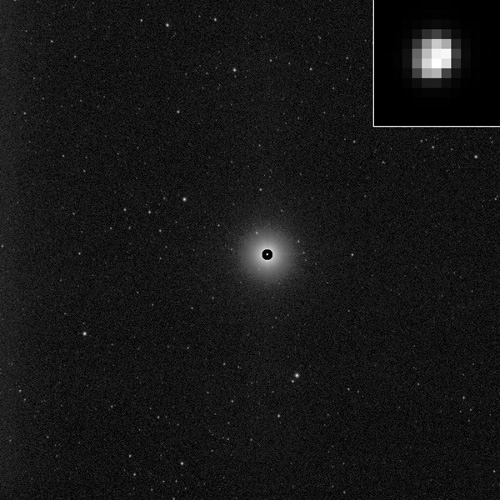
Image: This image, processed to show the true size of the giant asteroid Vesta, shows Vesta in front of a spectacular background of stars. It was obtained by the framing camera aboard NASA’s Dawn spacecraft on May 3, 2011, from a distance of about 1.2 million kilometers (750,000 miles). Since Vesta is so bright that it outshines its starry background, Dawn team members commanded a long exposure time to make the stars visible. They corrected the resulting exaggerated size of Vesta by superimposing a short exposure image of the target asteroid, showing its true size. Vesta is the small, bright pearl in the middle of the image. Credit: NASA/JPL.
Right now we’re still early in the approach phase, a time when Dawn is using its ion thrusters to match the asteroid’s orbit around the Sun, allowing it to enter into a spiraling orbit that begins with capture at about 16,000 kilometers. Also active are Dawn’s gamma ray and neutron detector instrument as well as its visible and infrared mapping spectrometer, taking early measurements and testing calibration to make sure they are ready for Vesta orbital operations.
“We feel a little like Columbus approaching the shores of the New World,” said Christopher Russell, Dawn principal investigator, based at the University of California in Los Angeles (UCLA). “The Dawn team can’t wait to start mapping this Terra Incognita.”
Yes, Vesta does have that feel about it, just as New Horizons will when it approaches Pluto/Charon. These are places we’ve only been able to examine from ground and space-based telescopes in the past, and as Dawn chief engineer Marc Rayman puts it, “Dawn will soon bring into focus an entire world that has been, for most of the two centuries scientists have been studying it, little more than a pinpoint of light.” Dawn’s thrusting will be interrupted once a week this month to take new images as Vesta goes from five pixels across to 12.
Rayman’s online journal of the Dawn mission is worth watching. In an entry from last year, he explains that Dawn’s ion thrusters allow it to gradually reshape its orbit around the Sun for orbital insertion at Vesta, a process far different from more conventional propulsion methods. Dawn’s thrusters are 10,000 times less powerful than the typical propulsion system on an interplanetary spacecraft, a gentle push that allows an entirely different flight profile, as Rayman explains by analogy:
To think about this facet of the difference between achieving this goal with the different technologies, imagine you want to drive your car along next to another traveling west at 100 kilometers per hour (60 miles per hour). The analogy with the conventional technology would be similar to heading north toward an intersection where you know the other car will be. You arrive there at the same time and execute a whiplash-inducing left turn at the last moment using the brakes, steering wheel, accelerator, and probably some adrenaline. When you drive an ion propelled car, operating with 10 times the fuel efficiency, you take a different path from the start, one more like a long, curving entrance ramp to a highway. When you enter the ramp, you slowly (perhaps even gently) build speed. You approach the highway gradually, and by the time you have reached the far end of the ramp, your car is traveling at the same speed and in the same direction as the other car. Of course, to ensure you are there when the other car is, the timing is entirely different from the first method, but the sophisticated techniques of orbital navigation are up to the task.
This July, the paths of Dawn and Vesta will have become so similar that, at a range of 16,000 kilometers, the spacecraft will be traveling at less than 50 meters per second relative to the asteroid. This is the point at which Vesta’s gravity will gradually take charge of Dawn. The ion thrusters will be shut down when the spacecraft finally reaches its ‘survey orbit,’ with each revolution taking about three days. Resumed thrusting after data acquisition will result in lower orbits as Dawn takes a closer look at its target. In 2012, the spacecraft will reverse its spirals and begin climbing away from Vesta as it moves toward its 2.5-year cruise enroute to Ceres.


